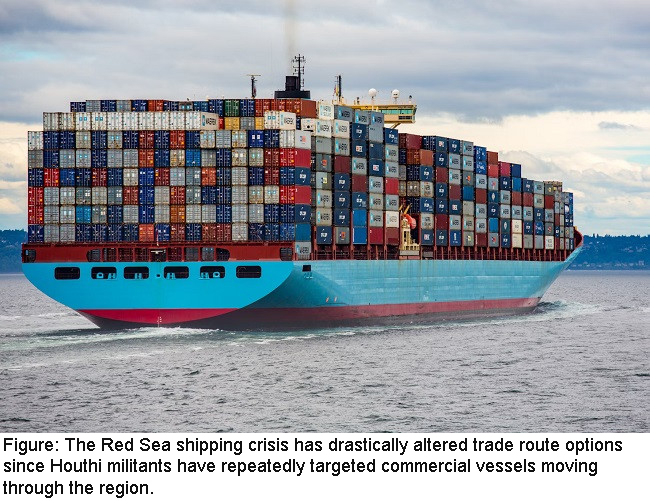
Category: SERVICES
Country: Bangladesh
By Emily Newton
Editor In Chief, Revolutionized
Posted on March 13, 2024 12:59 PM
The Red Sea shipping crisis has drastically altered trade route options since Houthi militants have repeatedly targeted commercial vessels moving through the region. How have textile manufacturers coped with this and what can they — and you — continue to do as the situation evolves?
Consider air freight during the Red Sea shipping crisis
The heightened danger along the Red Sea shipping route has caused people to adapt by choosing alternative, safer options that lengthen the journeys. Many textile buyers won’t tolerate those longer lead times, though, causing some Bangladeshi manufacturers to lose business.
Shovon Islam — owner and Managing Director of Sparrow Group — has several international clothing brands as clients. However, in January 2024, he lost a U.S. buyer’s order of 150,000 pieces that would have brought the manufacturer the equivalent of several million dollars. The buyer chose to work with an Indonesian competitor that offered a shorter lead time.
Islam explained that all the major shipping lines are dealing with the situation by sailing around Africa’s tip, but that decision brings a 50% increase in shipping costs and adds at least 10 days to the transit time frame. He also clarified how he and other Bangladeshi manufacturers are often disadvantaged at the bargaining table because of longer lead times stemming from several reasons.
The main issue is Bangladesh’s Chattogram Port lacks the depth for container ships to dock. The typical workaround is for garment manufacturers to export their products in feeder vessels that bring small batches to vessels elsewhere. However, that can add more than two weeks to the lead time.
Islam said the increased lead times pose constant challenges for Bangladeshi manufacturers. He believes the Red Sea shipping crisis will impact his country’s industry more than the Ukraine-Russia conflict.
Although using air freight as an alternative costs significantly more, it’s also much faster. Manufacturers must weigh the pros and cons. Is it worth accepting the costs to preserve a lucrative client relationship?
Understand when air freight makes the most sense
RDM Group’s Rakibul Alam Chowdhury said a European buyer insisted on shipping via air freight. Even though that costs up to 12 times more, Chowdhury said refusing would have ended future business from that client. That’s a good example of textile manufacturers needing to assess the short- and long-term impacts of meeting a client’s demands, even when doing so cuts into the bottom line.
Sending 1 kilogram of clothing from Bangladesh to Europe costs less than 20 cents by sea but as much as $3.50 by air. However, the total impact on manufacturers depends on the method. When Bangladeshi garment exporters send goods via the freight-on-board option, the buyers bear the shipping costs. However, with the cost-and-freight option, suppliers do.
When retaining a major buyer’s business is at stake, manufacturers dealing with shipping issues must consider whether to move ahead with air freight. Besides providing the speediness that keeps clients satisfied, the shorter transit times can eliminate other issues linked to lengthy delays, such as mold growth.
Spores range from 3 to 40 microns and shipping containers are excellent environments for them to flourish. Shipping products by air could prevent mold growth, which may otherwise make the most affected products unsellable, cutting into manufacturers’ profits beyond the Red Sea shipping crisis.
Keep buyers informed
Manufacturers caught up in the Red Sea must maintain outstanding communication with buyers. This is a fluctuating situation, so now is the time for textile manufacturers to control what they can. One way to do so is to set the right expectations.
Brands within and outside the garment industry have published statements explaining how they believe the Red Sea shipping crisis will affect their businesses. The information received from textile manufacturers can shape what’s provided to the public.
Consumers who receive excellent customer service and ongoing updates will be more likely to stick with affected manufacturers despite longer lead times. Customers will also appreciate hearing how parties mitigate the long-term effects. For example, Khairul Alam Suzan — Vice President of the Bangladesh Freight Forwarders Association — advocates for securing the supply chain and affected sea routes by having discussions with the nations in conflict to reach agreements.
Relatedly, he suggests strengthening inter-country relations with all affected nations to prevent economic ramifications and widespread suffering. Such efforts will take time, but they could be worthwhile. That’s particularly true since many analysts see no end in sight for the situation affecting the Red Sea trade route.
Nimbleness is a necessity
The unpredictableness of these circumstances requires textile manufacturers to monitor their supply chains and respond to emerging challenges. Knowing the most prominent obstacles and being ready to address them will help impacted enterprises cope with the challenging times and learn strategies to apply for future resilience.
Since this situation has caused extra costs for many affected parties, decision-makers should investigate practical solutions for cutting expenses elsewhere to make more room in the budget. When you show a willingness and ability to adapt, it’ll be easier to convince shoppers to keep buying.
Courtesy: Textiletoday.com
Copyrights © 2025 GLOBAL TEXTILE SOURCE. All rights reserved.